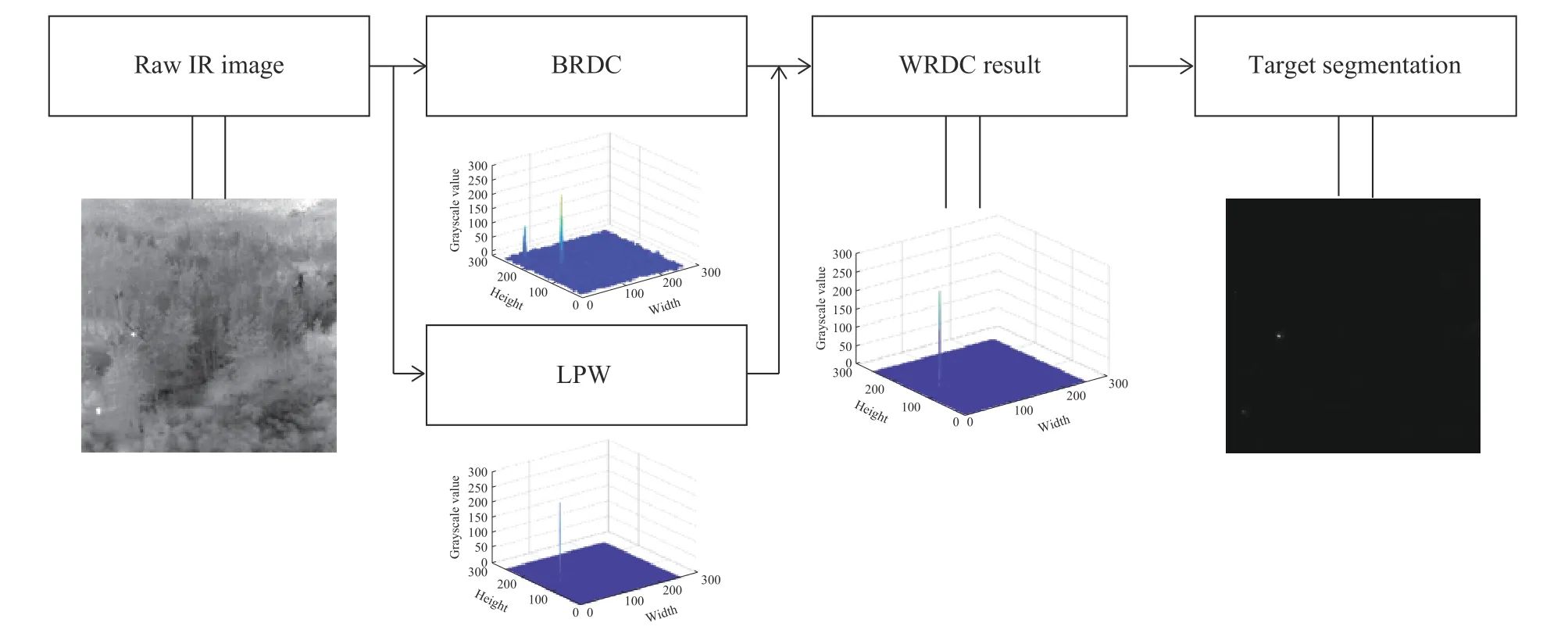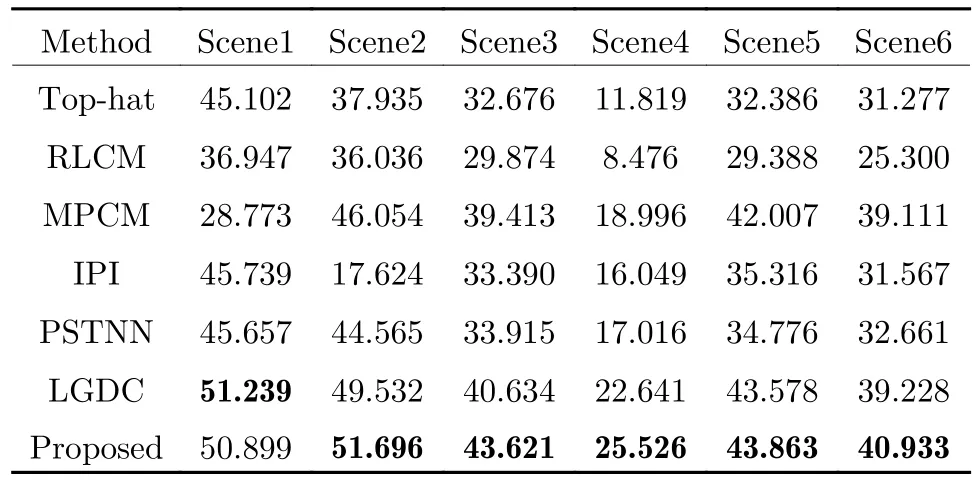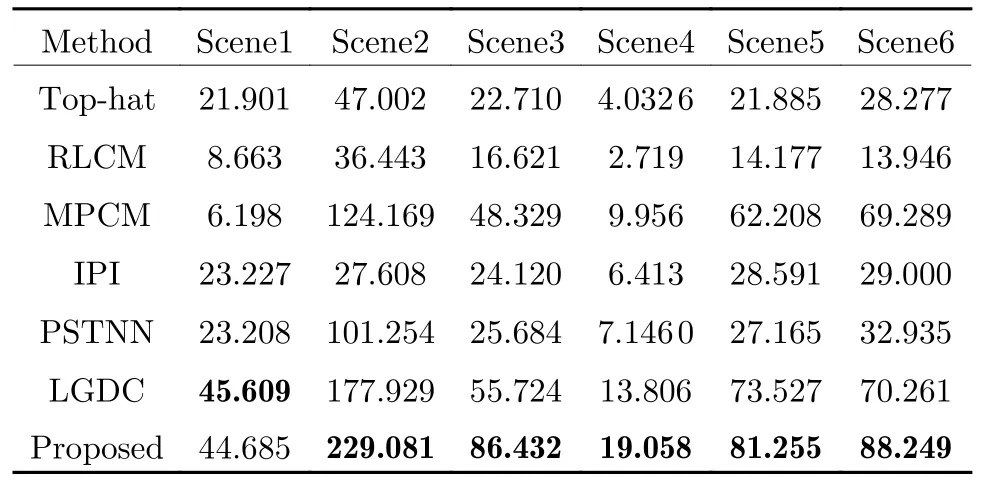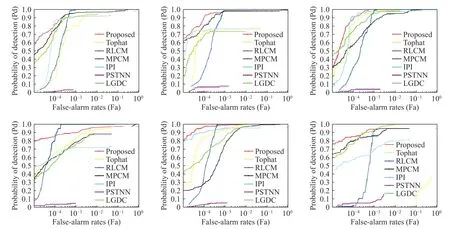Improved Weighted Local Contrast Method for Infrared Small Target Detection
Pengge Ma, Jiangnan Wang, Dongdong Pang, Tao Shan, Junling Sun, Qiuchun Jin
Abstract: In order to address the problem of high false alarm rate and low probabilities of infrared small target detection in complex low-altitude background, an infrared small target detection method based on improved weighted local contrast is proposed in this paper.First, the ratio information between the target and local background is utilized as an enhancement factor.The local contrast is calculated by incorporating the heterogeneity between the target and local background.Then, a local product weighted method is designed based on the spatial dissimilarity between target and background to further enhance target while suppressing background.Finally, the location of target is obtained by adaptive threshold segmentation.As experimental results demonstrate, the method shows superior performance in several evaluation metrics compared with six existing algorithms on different datasets containing targets such as unmanned aerial vehicles (UAV).
Keywords: infrared small target; unmanned aerial vehicles (UAV); local contrast; target detection
1 Introduction
Infrared small target detection is one of the key technologies of infrared search and tracking(IRST).It has a wide range of applications in the fields of accurate guidance and maritime surveillance [1-3].Due to long-range imaging,infrared (IR) small targets lack detailed shape and texture information.In addition, severe interference such as high-brightness background,edges of background and pixel-sized noises with high brightness (PNHB) exist in complex lowaltitude backgrounds, which make the detection very challenging.
In the field of IR small target detection, the methods of IR small target detection are mainly divided into single-frame detection method and sequential detection method.The single-frame detection method is usually used in infrared search and tracking system, we mainly study single-frame detection method in this paper.Tophat [4], Max-mean [5], and Max-median are single-frame detection methods based on morphological filtering.The core idea of these methods is to construct filtering operators that extract the target or background.These methods demonstrate high detection accuracy in scenes with simple backgrounds but are prone to high false alarm rates in scene with complex background.
In recent years, inspired by human visual system (HVS).IR small target detection methods based on local contrast have been extensively studied to achieve detection by measuring the difference between target and local background.Han et al.[6] proposed a relative local contrast measure (RLCM) that effectively suppresses different types of interference.Wei et al.[7] proposed a multi-scale patch-based contrast measure (MPCM), which combines the local grayscale differences in two corresponding directions to improve the detection performance.Deng et al.[8] proposed a detection method based on the average absolute gray difference (AAGD),which effectively improves the SNR of target by weighting local entropy with the gray difference.Wan et al.[9] proposed a method based on local gradient and directional curvature (LGDC) to detect single-frame infrared small targets, which significantly improved the contrast between target and background.In addition, methods based on low-rank and sparse decomposition are introduced into IR small target detection.These methods predict the position of target by an iterative optimization process.Gao et al.[10] proposed an infrared patch-image (IPI) method,which translates target detection into an optimization problem of recovering a low-rank and sparse matrix.Dai et al.[11] designed a weighted infrared patch tensor (IPT) model that integrates weighted infrared patch tensor with edge structural information.The model formulates the separation of target and background as a lowrank tensor recovery problem.Zhang et al.[12]proposed a method based on partial sum of tensor nuclear norm (PSTNN).When multiple targets with sparse structures exist in the scene and the background is complex, these methods exhibit low detection efficiency and typically result in high false alarm rates.
To address the challenge of detecting infrared small targets in complex low-altitude background, we propose a novel infrared small target detection method based on improved weighted local contrast [13].Firstly, the ratio information of target and local background is used as an enhancement factor.The local contrast is calculated by incorporating the heterogeneity between the target and local background.Then, a local product weighted method is designed based on the spatial dissimilarity between target and background [14].The final saliency map is obtained by multiplying local contrast and weighted function.Finally, the target is extracted through threshold segmentation.This method demonstrates strong detection performance in complex low-altitude backgrounds.
2 Improved Weighted Local Contrast Method for Infrared Small Target Detection
Fig.1 shows the general algorithm flow chart of this paper.The specific calculation process is mainly divided into three parts.

Fig.1 Algorithm flowchart
1) The block ratio-difference contrast(BRDC) is calculated by combining the homogeneity of target region with the heterogeneity between target and background regions.The local product weighted (LPW) mapping is computed based on spatial dissimilarity between target and background.
2) LPW realize the weighted enhancement of BRDC to obtain the final saliency map WRDC.
3) The target is extracted through threshold segmentation operation.
2.1 Infrared Small Target Detection
2.1.1 BRDC Calculation
The ratio of target and local background is used as the enhancement factor of target in this paper.The saliency map of BRDC is calculated as the difference between the grayscale values of the enhanced target region and the original target region, which simultaneously enhances target and suppresses complex background.BRDC is defined as follows
wheremB(i) denotes the average of grayscale values of thei-th background block,Njdenotes the average of thejlargest pixel grayscale values of the central block, and theNjvalues at different scales are defined as follows
whereLis the length of unit block in sliding window,Iikis the gray value of thek-th pixel in thei-th block,jis the number of maximum gray value of central block,is thek-th maximum gray value of central block T.
The design motivation of BRDC is as follows.
1) Some PNHB exist in complex low-altitude background, which interferes with detection of small targets.Some methods that use the maximum value of center block when calculating contrast in ratio form will identify PNHB as a target as well, which increases the false alarm rate.The use ofNjenhances precise representation of grayscale features of center block.It focuses more on local contrast between target and background rather than brightness.This method demonstrates a decent effect in suppressing PNHB.
2) The proposed method uses mean value of maximum gray value ofjpixels inNjof central block in the ratio operation, which further enhances the local contrast compared to traditional method using mean gray value of central block, and the effect of enhancing target is more obvious.
3) As shown in Eq.(1), the enhancement factor of the center block in different directions is obtained by the ratio operation ofNjandmB(i).The high brightness background can be effectively eliminated by using the formulato calculate the difference between enhanced grayscale value and initial grayscale value of center block.
The saliency map BRDC is calculated by traversing the entire image through a sliding window shown in Fig.2.According to Eq.(1), when the central block T passes through the target,since the real target is usually locally salient, we can get,which is used to enhance the target.When the central block T passes through background and surrounding blocks are target or background, since the background is usually continuous, we can get minwhich is used to suppress the background.

Fig.2 Sliding window
2.1.2 LPW Calculation
The calculation of the weighted function is mainly based on the spatial characteristics of the target and background and the difference between them.Typically, target follows a Gaussian distribution and exhibits minimal similarity to background.Therefore, an increase in the dissimilarity between central region and neighboring regions indicates high probability that central block is target.Local product weighted mapping is used to further suppress background.LPW is defined as follows
wheremTdenotes the average gray value of the central block T.LPW is the product value obtained by multiplying the difference between the gray average values of the central block and the eight neighboring blocks.
When the central block T passes through the target, since the difference between the target region and surrounding block is large,d(T,Bi)>0.Then, we get a large local product weighted mapping LPW to enhance the target.When the central block T passes through background.Since the background is a uniform area with some noise in the local region,d(T,Bi) ≤0.Then, we get a negative local product weighted mapping LPW to suppress the background.Therefore, LPW can realize the weighted enhancement of BRDC.The final saliency map WRDC is expressed as follows:
2.1.3 Multi-Scale WRDC Calculation
The local contrast can be measured more accurately when the size of the sliding window is approximately the same as target.A multi-scale calculation method is used to improve the algorithm’s robustness to the target of different size in this paper.The lengthLof the detection window are set to 3, 5, 7, 9.The formula for the multiscale calculation is defined as follows
wheremdenotes them-th scale,ldenotes the number of scales.
2.2 Extraction of Small Infrared Target
The WRDC saliency map is computed based on the calculations mentioned above.The real target is typically the most salient.To distinguish target from background, we define the threshold Th as
whereμis the mean of WRDC saliency map,kis a threshold factor with an optimal range of 0.6-0.8 andσis the standard deviation of WRDC saliency map.
3 Experiments and Results Analysis
In this section, the key parameterNin Eq.(3) is discussed and selected first.In this paper, a multi-scale sliding window of sizeL×Lis used for detection, where the size of target does not exceedL×L.It is experimentally verified that the optimal values ofNare 4, 12, 16, 24 whenL= 3,5, 7, 9.Then the proposed method is compared with six advanced algorithms on six sets of real IR sequences.The comparison algorithms used in the experiment are: Tophat [4], RLCM [6],MPCM [7], IPI [10], PSTNN [12], LGDC [9].In this experiment, six sets of IR image sequences in low-altitude scenes were used as the experimental datasets.The six datasets are denoted as Scene1-Scene6.Tab.1 shows the detailed description of the IR image datasets.A series of evaluation metrics are also used to evaluate the detection performance of different methods in order to verify the effectiveness and robustness of the proposed method.

Tab.1 Detailed description of the infrared image dataset
3.1 Visualization of Test Results Analysis
As shown in Fig.3, the detection results of six representative images are selected for visualization.These images contain detection results of each method in six datasets and the 3D distribution of detection results.
Scene1 shows an experimental scene containing dark sky and high-brightness ground background.The target is small and only occupies a few pixels, but the background is relatively uniform and dark.Therefore, the target is more prominent in the local region.Tophat based on morphological filtering can enhance target, but fail to adequately suppress high-brightness clutter in background, resulting in poor detection results.The proposed method can fully suppress the high-brightness background, while enhancing the target.It has better detection results.Scene2 shows the experimental results of different methods in scenarios with interference from complex clouds.Small infrared targets are submerged in bright cloud backgrounds and are difficult to detect.It can be seen from the result of the proposed method that the background of bright cloud is basically suppressed.The target is significantly enhanced.Tophat and MPCM fail to detect the target.MPCM has poor background suppression effect.There are interfering targets in Scene3, and the comparison method detects the targets, but the interfering targets are also retained in the detection result.The proposed method uses the spatial dissimilarity of weighted local contrast to suppress the background region where interfering targets exist for accurate target detection.Scene4 shows a low-altitude scene with complex background.RLCM enhances the target, but the original shape of the target is not retained.The background noise is also enhanced.IPI and PSTNN will lead to a high false alarm rate When high-brightness edges or sparse points exist in the background.Scene5 shows the experimental results of different methods for the background with strong interference.The background brightness of these strong interference is even higher than the target.The part of the background is similar to the target, resulting in false detection.The relatively continuous highbrightness background clutters exist in scene6.Many background clutters still exist in the detection results of Tophat, RLCM and PSTNN.The proposed method can suppress high-brightness background clutter and detect the target accurately.From the 3D distribution diagram, it can be seen that the most comparison methods can detect the target, but more background clutter remains in detection results, resulting in higher false alarm rate.The detection results of the proposed method are almost no background clutter,and target can be detected accurately.These visualization results demonstrate that the proposed method possesses strong target responsiveness and background suppression capability.
3.2 Comparative Analysis of Target Enhancement and Background Suppression Performance
In order to quantitatively evaluate the target enhancement capability and background suppression capability of all methods.The calculation formulas of signal-to-noise ratio gain (SNRG)and background suppression factor (BSF) are introduced:

Fig.3 Visualize the result graph: (a) scene1; (b) scene2; (c) scene3; (d) scene4; (e) scene5; (f) scene6
where SNRoutand SNRindenote the SNR of WRDC and original image.
whereCin,Coutdenote the standard deviation of the gray value of original image and WRDC.
The SNRG and BSF for all methods tested on the six sets of IR images are presented in Tab.2 and Tab.3.The bolded numbers indicate the maximum values.The proposed method combines local contrast with weighted function and achieves the maximum SNRG and BSF in most scenes.LGDC combines gradient features and directional curvature to calculate local contrast and achieves the maximum SNRG and BSF in a few scenes.It can be concluded from the analysis that the proposed method exhibits strong back-ground suppression and target enhancement capability.

Tab.2 Different algorithms for SNRG
3.3 Comparative Analysis of Testing Performance
In the field of IR small target detection, receiver operating characteristic (ROC) curve is widely used to evaluate the robustness of algorithm,while reflecting the variation relationship between probabilities of detection (Pd) and false alarm (Pf).
whereNdis the number of correctly detected small targets,Ntis sum of the number of real small targets,Nfis the number of falsely detected small targets, andMis the total number of detected targets.
Fig.4 shows the ROC curves of the averageperformance of each method in six datasets.It can be seen that the overall detection performance of the proposed method is the strongest,with high probabilities of detection while ensuring a low false alarm rate.It outperforms other comparison methods on most of the test images,which further demonstrates the effectiveness of the proposed method.

Tab.3 Different algorithms for BSF

Fig.4 ROC curves of different algorithms: (a) scene1; (b) scene2; (c) scene3; (d) scene4; (e) scene5; (f) scene6
3.4 Average Calculation Time Comparison Analysis
In addition, all experiments were implemented on a computer equipped with an Intel Core 2.9-GHz i5-9400 CPU and 16-GB memory, and the testing software was MATLAB R2018b.
To verify the real-time performance of the proposed method, Tab.4 lists the Average calculation time of different algorithms.Among all algorithms, Tophat, MPCM, PSTNN and the proposed method have faster average calculation time.IPI has the slowest calculation time.The proposed method exhibits greater advantages in terms of probabilities of detection and false alarm compared to Top-hat and LGDC, which have similar detection efficiency.Additionally, it possesses strong real-time capability.

Tab.4 Average calculation time of different algorithms (s)
4 Conclusion
In order to improve the accuracy and robustness of IR small target detection in complex low-altitude scenes, we propose an infrared small target detection method based on improved weighted local contrast.It consists of the following components.First, the ratio information between the target and local background is utilized as an enhancement factor.The local contrast is calculated by incorporating the heterogeneity between the target and local background.Then, we designed a weighted function based on the spatial dissimilarity between target and background.The experimental results show the method has obtained good detection results on multiple evaluation metrics, with strong detection performance and robustness in different low-altitude scenes.In future work, the proposed method will be validated in scenes containing multiple targets to provide a more reliable solution for practical applications.
 Journal of Beijing Institute of Technology2024年1期
Journal of Beijing Institute of Technology2024年1期
- Journal of Beijing Institute of Technology的其它文章
- WSN Mobile Target Tracking Based on Improved Snake-Extended Kalman Filtering Algorithm
- Equalization Reconstruction Algorithm Based on Reference Signal Frequency Domain Block Joint for DTMB-Based Passive Radar
- A Novel Clutter Suppression Algorithm for Low-Slow-Small Targets Detecting Based on Sparse Adaptive Filtering
- An Efficient Radar Detection Method of Maneuvering Small Targets
- Detection of UAV Target Based on Continuous Radon Transform and Matched Filtering Process for Passive Bistatic Radar
- Robust Space-Time Adaptive Track-Before-Detect Algorithm Based on Persymmetry and Symmetric Spectrum
